

| Return to Index |
|
Paper 56 A Selection of Balls from 1811Contributed by Paul Cooper, Research Editor [Published - 16th April 2023, Last Changed - 8th January 2025]In this paper we'll continue the theme of studying a selection of historical balls that were all held in the same year. The selection isn't entirely random, the balls have been picked as some of the dancing at these events can be reconstructed, albeit imperfectly. We'll consider seven such balls in this paper, in so doing we'll discover several country dancing tunes that were popular in the year 1811. There's no connecting theme for the events other than that they were all held in the same year, most were held in London and all were hosted by members of Britain and Ireland's aristocracy and gentry. The tunes and dances that we'll consider further in this paper are:
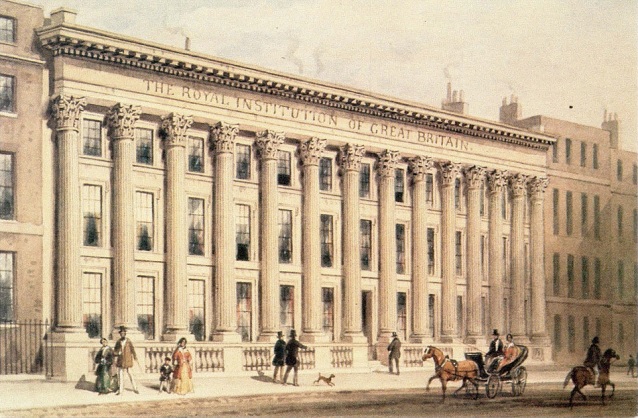 Figure 1. The Royal Institution on Albermarle Street, c.1838. Our ball of 1811 was held on the the same street.
Figure 1. The Royal Institution on Albermarle Street, c.1838. Our ball of 1811 was held on the the same street.
Marchioness Dowager of Lansdowne's BallThe first event we'll study was hosted by the Marchioness Dowager of Lansdowne. The Morning Post newspaper for the 23rd of March 1811 wrote of this ball (with dance references in Bold): A splendid Ball was given by the above distinguished Lady, at her residence, in Albemarle-street, on Thursday night. The magnificent proportions of the state apartments; their uniquely beautiful and very costly embellishments; the exquisitely fine collection of inestimable pictures; the vases, statues, and other precious relicts of antiquity, were the admiration of the company, exceeding in number 400 of the leading Fashionables now in town. The effect of all these varieties was considerably heightened by the admirable disposition of the lights. A brilliant Grecian chandelier, carrying an innumerable quantity of wax candles was happily disposed in a situation to shew the uncommonly chaste style of the furniture to the best advantage. Where the productions of Guido, Titian, Corregio, and Van Dyke, were hung, a quiet light, produced by an opake lamp (the largest ever seen), gave an interest to the subjects which multiplied their perfections ad infinitum. The dancing commenced at eleven o'clock with the favourite tune of...Lady Montgomery,led off by Mr Lyon and Miss Giffard. Next followed:- The Marchioness Dowager of Lansdowne was born Lady Mary Arabella Maddox (d.1833), she had married John Petty, 2nd Marquess of Lansdowne (1765-1809) in 1805. The Marquess died in 1809 and the title passed to his brother Henry (1780-1863), she evidently retained access to their London mansion. The Marquess was her second husband, she had first married the Irish peer Duke Giffard (d.1801, Saunders's News-Letter 2nd of January 1802); she had several children from the first marriage presumably including the Miss Giffard who led off the first dance with Mr Lyon. Miss Giffard may have been her daughter Maria who was understood to have been born in 1798, this would make her only 13 years old at the date of the ball (which seems improbable but isn't impossible). Alternatively, perhaps the Miss Giffard who danced was the daughter of one of her first husband's relatives. The first tune to be danced was Lady Montgomery's Reel, an immensely popular tune that we've written about before. The second dance was a Waltz Medley. A Waltz medley is a sequence of Waltz tunes to which the couple-waltz would be danced. We've written of Waltz Medleys elsewhere, you might like to follow the link to read more. The Waltz couple dance was considered risque at the 1811 date of our ball though it was widely danced. One commentator on the waltz in 1811 recommended that that genteel couples should hold each other by the elbows to form an open circular embrace, the dancing at our ball may have involved something polite of that nature (Morning Post, 5th of August 1811). Many leading members of the aristocracy were present for this ball; we're not informed precisely who was waltzing, the newspapers rarely identified dancers except for the first dance of the evening, the identity of the waltzing couples seems not to have been of interest.
We're informed that
Mrs Calvert's BallThe Morning Post newspaper for the 13th of May 1811 wrote of this ball (with dance references once again in Bold): 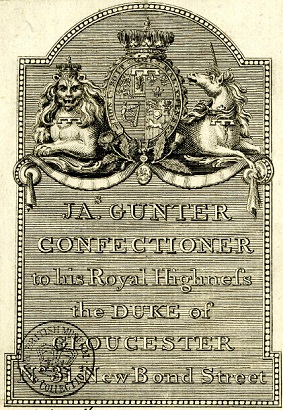 Figure 2. James Gunter's trade-card, 1810. Image courtesy of the British Museum.
Figure 2. James Gunter's trade-card, 1810. Image courtesy of the British Museum.
A very magnificent Ball and Supper were given, on Friday evening, in Mansfield-street, Portland-place. The interior decorations were very elegant. About half-past eleven o'clock, the dancing commenced with...The Prince Regent's Medley, (an entirely new and very lively tune), led off by Sir David Hunter Blair and Miss Calvert. Next followed:- Mrs Calvert (1767-1859) was the wife of Nicholson Calvert (1764-1841), the Member of Parliament for Hertford. She was born Frances Pery, the daughter of Viscount Pery, they had married in 1789. She was reputed to have been a popular society hostess and a personal friend of the Prince of Wales. The Calvert's daughter Lavinia was born in 1791 and was 19 years old at the date of the Ball, it's likely that she was the Miss Calvert who led off the first dance with Sir David Hunter Blair (1778-1857). The two tunes that are named as having been danced were both medleys and both in the waltz style. We've written of the The Regent's Medley before, we'll go on to study The Marquis of Queensbery's Medley shortly below. Nathaniel Gow published both Medleys in Edinburgh in a publication of 1811, it's therefore quite likely that the London based Gow band (under John Gow) provided the music for our Calvert ball (either the publication was influenced by this event, or the event by the publication). The Marquis of Lansdowne (son of our preceding hostess) is reported to have acted as superintendant of the dancing, presumably he was the Master of the Ceremonies, or perhaps served in a less formal role, for the evening. The confectionery was provided by James Gunter (1731-1819) of New Bond Street, he was a celebrated Italian Confectioner who had catered for many society balls; a copy of Gunter's trade-card can be seen in Figure 2.
Lady Metcalfe's Ball Figure 3. Portland Place c.1790. Image courtesy of the British Museum.
Figure 3. Portland Place c.1790. Image courtesy of the British Museum.
The Morning Post newspaper for the 16th of May 1811 wrote of this ball (with dance references in Bold): The above Lady gave a very elegant Ball and Supper, on Tuesday night, at her splendid mansion in Portland-place. The principal rooms (three in number) were lighted up by wax-candles, places in cut glass chandeliers, lustres, and chrystal lamps. Precisely at half-past eleven o'clock, the ball was opened by the Earl of Ilchester and the Hon. Miss Metcalfe, toThe Castillian Dance,a new and spirited tune. Among the couples (twenty in number) who went down were:- Lady Metcalfe, the hostess of this event, was born Susannah Debonnaire (1756-1815), she was the daughter of a European trader in India. She had previously married a Major in the Bengal Infantry who died almost immediately thereafter in 1777. She married Sir Thomas Metcalfe (1745-1813, later 1st Baronet) in 1782, he was another major in the Bengal Infantry at the time. The Metcalfes had eight children together. Sir Thomas served as a director of the East India Company between 1789 and 1812 and was the Member of Parliament for Abingdon between 1796 and 1807. Their daughter Emily was just about to turn 21 at the date of their ball, she led off the first dance with the 24 year old Henry Fox-Strangways, 3rd Earl of Ilchester (1787-1858). We're informed that twenty couples followed Emily and Henry down the first country dance, their immediate successors being William Wellesley Pole (1788-1857) and Catherine Tylney Long (1789-1825); this couple are particularly noteworthy as they married each other in 1812 - they are a rare example of a couple who were named as having danced together in a newspaper who went on to marry each other. Indeed, they are the first such example that I have stumbled upon. Two tunes are named as having been danced at the Ball, The Castillian Dance and Lady Matilda Bruce's new Reel, we'll go on to study them both shortly.
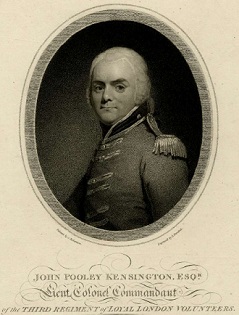 Figure 4. John Pooley Kensington, 1805. Image courtesy of the British Museum.
Figure 4. John Pooley Kensington, 1805. Image courtesy of the British Museum.
Mr Kensington's Grand Ball, Lime-GroveThe Morning Post newspaper for the 24th of May 1811 wrote of this ball (with dance references in Bold): The elegant mansion of this Gentleman was on Wednesday thrown open. About nine the company began to assemble, including all the families of rank and fashion in the neighbourhood. The grounds and the approach to the house were most superbly illuminated with coloured lamps in variegated devices. The floors were most tastefully ornamented with coloured chalks, emblematic of our late brilliant victories, and the windows were filled with the most rare plants from the conservatory. About ten the Ball commenced, which was led off by Miss Kensington and Mr Whitmore, to the fashionable air ofJuliana. At two the company, consisting of nearly 200 persons, sat down to a most magnificent supper; after which, dancing recommenced; and the company did not depart till a late hour, charmed with the attention and hospitality of their Host, and the affability and taste of Mrs Kensington, under whose directions the whole entertainment was arranged.
John Pooley Kensington (1764-1818) was the host for this ball. He was a banker and also the Lieut Colonel Commandant of the 3rd Regiment of the Loyal London Volunteers (they were the Frances Kensington, who led off the first dance, went on to marry an Edward Whitmore (1784-1857) in 1812. Edward was presumably Frances' partner in that first dance. This makes for another rare discovery of a couple who would go on to get married having previously danced together at a society ball. On this occasion they led off the first dance of the evening together. Mr Kensington, the host, would unfortunately be declared bankrupt in 1813, perhaps the lavish scale at which he was entertaining the social elite was unsustainable. A single tune was named as having been danced at this event, Juliana, we'll study it further shortly.
Mrs Chandos Pole's BallThe Morning Post newspaper for the 5th of June 1811 wrote of this ball (with dance references in Bold): 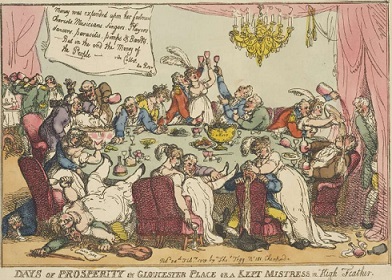 Figure 5. Days of Prosperity in Gloucester Place, or a Kept Mistress in High Feather, 1809. Image courtesy of the British Museum.
Figure 5. Days of Prosperity in Gloucester Place, or a Kept Mistress in High Feather, 1809. Image courtesy of the British Museum.
The above Lady gave a Ball and Supper of the most elegant description on Monday night, at her house in Gloucester-place. The two drawing rooms were both appropriated for dancing in. About half past eleven o'clock the Ball was opened with a new dance called...The Recovery. The following were among the couples:- The hostess of this event was Mary Chandos Pole (c.1775-1848). She was born Mary Ware, a daughter of Rev Henry Ware the Rector of Balrothery in Ireland. She married Sacheverell Pole (1769-1813) in 1791. Pole was the inheritor of the Radbourne estate in Derbyshire. He could trace his lineage back to Sir John Chandos (c.1320-1369), a founding Knight of the order of the Garter, also a hero of the Hundred Years War. Sacheverell Pole received Royal License in 1807 to change his surname from Pole to Chandos Pole in tribute to this honoured ancestor; thus our hostess became Mrs Chandos Pole from that date. The couple had at least six children together, three sons and three daughters. The Miss Pole who led off the first dance was presumably their daughter Elizabeth Chandos Pole (1793-1873). Her partner in the dance was the 31 year old Henry Greville (1779-1863), later the Earl of Warwick. The attendees at the party included a large number of society fashionables. Two tunes are named as having been danced at this event, The Recovery and The Pic Nic. We'll go on to study both of these tunes shortly.
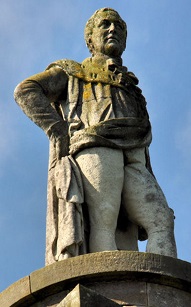 Figure 6. Statue of the 3rd Marquis of Downshire at Hillsborough, 1848
Figure 6. Statue of the 3rd Marquis of Downshire at Hillsborough, 1848
Hillsborough BallThe Globe newspaper for the 1st of August 1811 wrote of this ball (with dance references in Bold): On Wednesday evening the Ball was fashionably attended, was led off by the Marquis of Downshire and Lady Harriet Savage, to the tune ofLord McDonald's Reel. Among the company were, the Marquis and Marchioness of Donegal; Lady Clanwilliam, Lady Maria Meade, Lady Sarah Butler; the Misses Montgomery; Sir George Hill; Col. Meade; Col. Forde, &c.&c. This ball was held as part of the annual Hilsborough Races in Ireland. We've investigated the dancing at the Perthshire Race Week of 1809 and 1810 in a previous paper, you might like to follow the link to read more. The Hillsborough Ball will have been a similar event to that held in Perth the previous year. The Marquis of Downshire who led off the first dance was Arthur Hill (1788-1845), the Downshires were the most prominent family in the local area. A large statue of Arthur still stands in Hillsborough atop a giant column (see Figure 6). Arthur led down the dance with Lady Harriet Savage (d.1865), the wife of Francis Savage (1768-1823). It's unusual to discover a married lady dancing in a country dance at this date, one might have expected a young and wealthy bachelor like Arthur to have been a desirable partner. He would go on to marry Lady Maria Windsor (1790-1855) in October of 1811. Only one tune is explicitly named as having been danced at the Ball, Lord McDonald's Reel, we'll go on to study it shortly.
Margate BallThe Saunders's Newsletter newspaper for the 30th of October 1811 wrote of this ball (with dance references in Bold): 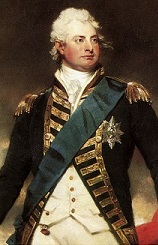 Figure 7. The Duke of Clarence c.1800
Figure 7. The Duke of Clarence c.1800
Margate, October 24. Last night his Royal Highness the Duke of Clarence honoured our Rooms with his presence, and Mr. Le Bas had the honour of ushering his Royal Highness into the Ball Room, who appeared highly gratified at the politeness of our accomplished Master of the Ceremonies. The Ball was opened at half-past nine, by his Royal Highness, with Mrs McMahon, to the tune ofPaddy O'Carrol. The second and third dance was led off by his Royal Highness, with the beautiful and accomplished Miss Thompson, to the tunes ofLa Blaize BerbetandWe'll gang nae more to yon Town. The final ball we're studying in this paper was held at the resort town of Margate under the direction of their veteran Master of the Ceremonies, Mr Le Bas. Le Bas had occupied the role of M.C. at both Ramsgate and Margate since at least as early as 1789 (Kentish Gazette, 1st of September 1789). This particular ball was graced by the Duke of Clarence (1765-1837), the King's third son, who would in 1830 go on to become King William IV (see Figure 7). It was evidently well attended by the those members of the aristocracy present in the area at the time.
Another attendee was Colonel John McMahon (c.1754-1817) the private secretary to the Prince Regent. McMahon, according to the History Of Parliament website, married We've studied one of the three tunes named as having been danced at this event before, that was I'll Gang Nae Mair to Yon Town, it was the favourite tune of the Prince Regent. We'll study the other two tunes, Paddy O'Carrol and "La Blaize Berbet" shortly.
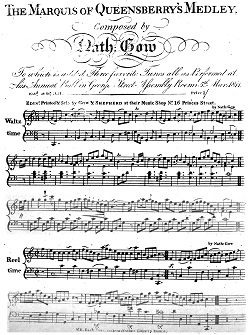 Figure 8. Nathaniel Gow's 1811 The Marquis of Queensberry's Medley
Figure 8. Nathaniel Gow's 1811 The Marquis of Queensberry's Medley
The Marquis of Queensberry's MedleyThe second dance was likewise a new one, viz:- The Marquis of Queensbery's Medley. These dances were completely in the waltz style.(Mrs Calvert's Ball)
The first tune we'll consider from across our 1811 balls is named The Marquis of Queensberry's Medley. The Marquis of Queensberry was, in 1811, Sir Charles Douglas (1778-1837). He had inherited the title from a distant cousin the year before in 1810, the medley was presumably composed in his honour at around this same date. The composer of the medley was Nathaniel Gow, he issued it in 1811 in a publication of the same name (see Figure 8) that also included his Prince Regent's Medley. Gow, according to the cover of his publication, had performed the medley in Edinburgh
The Medley was composed in two parts, it began with a Waltz tune in 6/8 rhythm and concluded with a Reel in Common time. A footnote in Gow's publication indicated that This particular medley is known to have been featured at one further event of 1811, Mrs Crawford Bruce's Ball (Morning Post, 30th of May 1811). It was led off at that event by Viscount Hawarden and Miss Bruce. It may of course have been danced elsewhere too, I've failed to find any further references to it however. Gow's Medley seems not to have been published by the London music sellers, at least not in its entirety. At least two London publishers issued versions of the Reel tune (the second part of the Medley), it can be found in the Cahusac collection of 12 Country Dances for 1813 and also in the Preston collection of 24 Country Dances for 1815. I've not found any versions of the Waltz tune amongst the London publications however. We've animated a suggested arrangement of the Cahusac version for 1813. For futher references to the tune, see also: Marquis of Queensbury at The Traditional Tune Archive.
The Castillian Dancethe ball was opened by the Earl of Ilchester and the Hon. Miss Metcalfe, to The Castillian Dance, a new and spirited tune.(Lady Metcalfe's Ball) The next tune to consider was named the Castillian Dance. At least two different tunes have been published under this name; one example can be found in Button & Whitaker's c.1807 5th Number, the other in James Platts's 1812 30th Number. The two tunes are entirely unrelated, their similarity in name appears coincidental. Neither tune was widely published but one has a much stronger claim to probably having been danced at our ball, that tune is the 1812 version published by James Platts (see Figure 9). 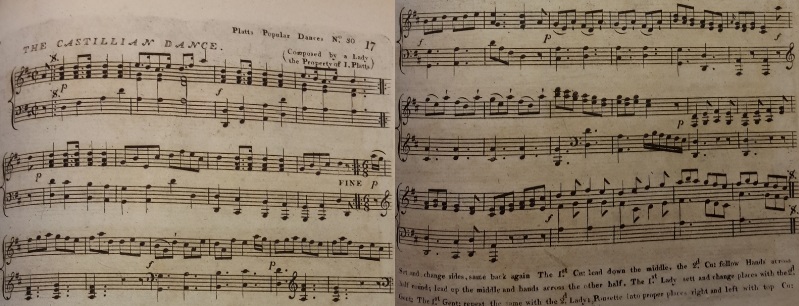 Figure 9. The Castillian Dance from James Platts's 1812 30th Number. Image © THE BRITISH LIBRARY BOARD, h.726.m.(10.) ALL RIGHTS RESERVED.
Figure 9. The Castillian Dance from James Platts's 1812 30th Number. Image © THE BRITISH LIBRARY BOARD, h.726.m.(10.) ALL RIGHTS RESERVED.
The Platts tune is unusual for several reasons. Once consideration is that it was written in two different time signatures, the first part is in common time and the second part in 6/8 measure; one might almost describe it as a
Platts didn't name the composer of his tune but we can make an educated guess as to her identity. Platts had previously published several other tunes that he identified as being composed by How Platts came to publish the tune after Lady Ashbrook's decease is unclear. Perhaps a family member had supplied tune to Platts for posthumous publication, knowing that he had previously published some of her other dances; or perhaps he had received a copy before her untimely death. The suggested dancing figures attached to the tune are also a little unusual, perhaps Lady Ashbrook had arranged those figures herself. I'm not aware of any other music sellers issuing copies of this tune, or of any other balls to feature the tune. We've animated a suggested arrangement of the dance here.
Lady Matilda Bruce's Reel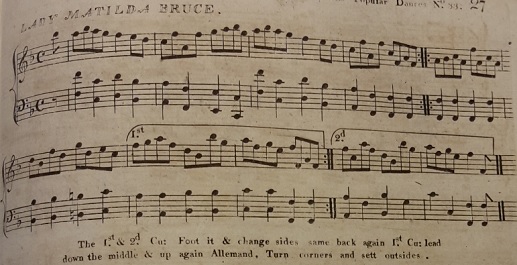 Figure 10. Lady Matilda Bruce from James Platts's c.1812 33rd Number. Image © THE BRITISH LIBRARY BOARD, h.726.m.(10.) ALL RIGHTS RESERVED.
Figure 10. Lady Matilda Bruce from James Platts's c.1812 33rd Number. Image © THE BRITISH LIBRARY BOARD, h.726.m.(10.) ALL RIGHTS RESERVED.
The second dance was much admired; it was called Lady Matilda Bruce's new Reel.(Lady Metcalfe's Ball) Lady Matilda Bruce (1802-1857) was the second daughter of Thomas Bruce (1766-1841), the 7th Earl of Elgin. She was around nine years old at the date of our ball. She suffered the misfortune of her parent's very public divorce in 1807 (under English law) and in 1808 (in the Scottish courts), it was something of a scandal and involved an Act of Parliament. Matilda's mother, Mary Bruce (1778-1855), had been accused of adultery. The facts of the divorce are unclear, her mother did however remarry in 1808 (her second husband being the man with whom she was accused of committing adultery), her father did so too in 1810.
The tune was composed and dedicated to Lady Matilda by Nathaniel Gow and was published in Edinburgh in a collection of the same name in 1810. Gow described the collection as being
Lady Matilda Bruce's Reel was promoted by the Gows from around 1810 and achieved wider support in 1811. In addition to our Metcalfe ball it also featured at The Duchess of Bedford's Ball (Morning Post, 3rd of June 1811) where it was the first dance of the event and where the Gow band led the music. It was also used at Lady Mary Lindsay Crawfurd's Party (Morning Post, 24th of June 1811) where it was described as The London music sellers began issuing arrangements of the tune from around 1811; examples include William Campbell's c.1811 26th Book, James Platts's c.1812 33rd Number (see Figure 10), Skillern & Challoner's c.1812 16th Number, Wheatstone & Voigt's c. 1813 8th Book, Augustus Voigt's Fashionable Country Dances for the Year 1814 and in Button & Whitaker's c.1814 26th Number (I've not been able to confirm this last reference as I don't have a copy to review). We've animated a suggested arrangement of the Platts version from around 1812 (see Figure 10). For futher references to the tune, see also: Lady Matilda Bruce's Reel at The Traditional Tune Archive.
JulianaAbout ten the Ball commenced, which was led off by Miss Kensington and Mr Whitmore, to the fashionable air of Juliana(Mr Kensington's Grand Ball) 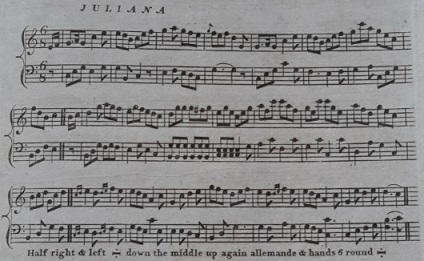 Figure 11. Juliana from George Walker's c.1811 27th Number.
Figure 11. Juliana from George Walker's c.1811 27th Number.
Juliana was a popular tune that was widely published by London's music sellers between the years 1810 and 1813. The origins of the tune remain a bit of a mystery however, so too does the meaning of the name. It may perhaps have been derived from a stage performance c.1810, if so then the details remain lost. The precise sequence of publication is unknowable but examples include: Dale's c.1810 17th Number, Wheatstone & Voigt's c.1810 5th Book, Campbell's c.1810 25th Book, Walker's c.1811 27th Number (see Figure 11), Monzani's c.1811 18th Number, Goulding's c.1811 19th Number, Andrews's c.1811 29th Number, Skillern & Challoner's c.1811 14th Number, Button & Whitaker's 1811 17th Number, Hime's c.1812 11th Number and Parry's c.1813 Collection of New & Favorite Country Dances & Waltzes. It was also referenced in Thomas Wilson's Treasures of Terpsichore publications for both 1810 and 1811, in Edward Payne's 1814 New Companion to the Ballroom and in Wilson's 1816 Companion to the Ballroom. An unrelated tune with the similar name of Julien's Cottage was also circulating at around the same date, there is some evidence of confusion between the two tunes; for example, Martin Platts's c.1813 7th Number included a tune that he named The Hornsey Dance, or Juliana's Cottage; it's not our tune but it does demonstrate an uncertainty amongst music sellers.
Our Juliana tune was also danced socially. It was danced at our event in 1811 and also at a Broadstairs Ball later that same year (The Globe, 8th of October 1811), at Margate the following year in 1812 (The Star, 9th of January 1812) and at The Hon Miss Knox's Ball in 1813 (Morning Post, 16th of March 1813). It was even described as being We've animated suggested arrangements of Dale's c.1810 version, of Wheatstone & Voigt's c.1810 version and of Walker's c.1811 version (see Figure 11). For futher references to the tune, see also: Juliana at The Traditional Tune Archive.
The RecoveryAbout half past eleven o'clock the Ball was opened with a new dance called The Recovery(Mrs Chandos Pole's Ball)  Figure 12. The Recovery from James Platts's 1811 28th Number. Image © THE BRITISH LIBRARY BOARD, h.726.m.(10.) ALL RIGHTS RESERVED .
Figure 12. The Recovery from James Platts's 1811 28th Number. Image © THE BRITISH LIBRARY BOARD, h.726.m.(10.) ALL RIGHTS RESERVED .
Several different tunes named
King George fell dangerously ill once again in late 1810. In early 1811 his first son was duly appointed Prince Regent and went on to rule in his place, thus began
It was at this time that the new tune named The precise sequence of publication cannot be known but examples include: James Platts's 1811 28th Number (see Figure 12), Monzani's c.1811 21st Number, Wheatstone's c.1811 24th Number, Goulding's c.1811 23rd Number, Clementi's c.1811 23rd Number, Hodsoll's c.1811 15th Number, Halliday's c.1811 9th Number, Falkner & Christmas's c.1811 1st Number, Campbell's c.1811 26th Book and Wheatstone & Voigt's c.1811 6th Book. It also featured in Skillern & Challoner's c.1812 17th Number, Andrews's c.1812 32nd Number, Walker's c.1812 30th Number, Dale's c.1812 18th Number, Button & Whitaker's c.1812 19th Number, Cahusac's collection of 12 Country Dances for 1813, Goulding & Co's 1813 2nd Collection of New & Favorite Country Dances, Reels, & Waltzes, Gerock's collection of 24 Country Dances for 1813 and in Bland & Weller's collection of 24 Country Dances for 1813. It would also be referenced in both Edward Payne's 1814 New Companion to the Ballroom and in Thomas Wilson's 1816 Companion to the Ballroom. Nathaniel Gow included the tune in his A Select Collection of Original Dances that was published in Edinburgh in 1815. It was also danced socially. In addition to our ball of 1811 it would also feature at a ball held by Mrs F.G. Smyth in 1811 (Morning Post, 10th of May 1811), at Lady Mildmay's Ball in 1811 (Morning Post, 8th of July 1811) and at a Broadstairs Ball of 1812 (The Globe, 22nd of September 1812). It was clearly both a popular and patriotic tune. We've animated suggested arrangements of the Platts version of 1811 (see Figure 12), the Hodsoll version of c.1811 and of the Button & Whitaker version of c.1812. For futher references to the tune, see also: Recovery (1) (The) at The Traditional Tune Archive.
The Pic Nic DanceThe Pic Nic, another novelty, distinguishable for its grace and spirit, followed(Mrs Chandos Pole's Ball) 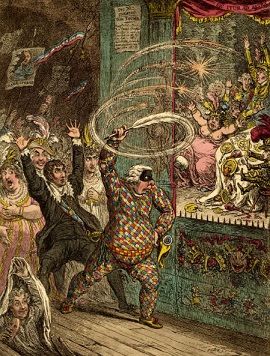 Figure 13. Blowing up the Pic Nic's, -or- Harlequin Quixotte attacking the puppets, 1802. Image courtesy of the British Museum.
Figure 13. Blowing up the Pic Nic's, -or- Harlequin Quixotte attacking the puppets, 1802. Image courtesy of the British Museum.
The word A picnic involved each of the participants bringing a separate dish for the enjoyment of the company. Early references to picnics appeared in the press in 1801, hosts including Mr H. Greville (Morning Post, 26th of May 1801) and Me Le Texier (Morning Post, 22nd of June 1801). The Duchesses of Devonshire and Buccleuch were both reported to have been present at the second of these two events. Shortly thereafter a new social club was formed variously known as the Picnic Club, Picnic Society or Picnic Theatrical Society. TheAs the expression of a Pic-Nic Supper is become so fashionable, though it is much oftener used than understood, it may be necessary to explain it for the information of many of our Readers:- rulesfor this new club were printed in the Morning Post newspaper for the 20th of February 1802; the society would host private theatrical entertainments at their Play-house in Tottenham-Street, attendance would be limited to 300 select guests, and after the Plays, or Proverbs, the Theatre will be convened into a Ball-room, and Apartments made ready for such of the Company as chuse Cards; at Half past Twelve there shall be a Pic-Nic Supper, succeeded by Catches and Glees. Twelve lady patronesses were appointed, the foremost of whom was the Duchess of Devonshire; the Director for the whole Establishmentwas given as Henry Francis Greville, Esq (1760-1816) (the very same person to have hosted the first of the documented-by-newspaper picnics in 1801).
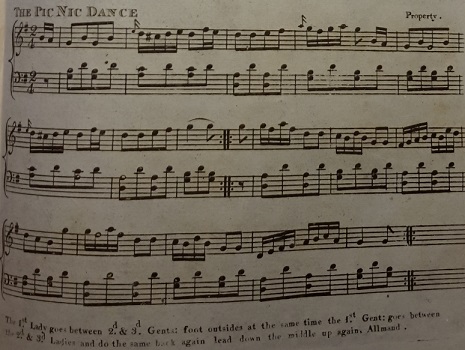 Figure 14. The Pic Nic Dance from James Platts's 1811 28th Number. Image © THE BRITISH LIBRARY BOARD, h.726.m.(10.) ALL RIGHTS RESERVED.
Figure 14. The Pic Nic Dance from James Platts's 1811 28th Number. Image © THE BRITISH LIBRARY BOARD, h.726.m.(10.) ALL RIGHTS RESERVED.
the company sat down to their Pic Nic, composing a dinner seldom equalled for abundance, variety and delicacies..
By 1810 the word At least two dance tunes named Pic Nic were published, one in 1809 and another in 1811. The 1809 tune was credited to Nathaniel Gow and was published in Edinburgh in the 1809 A 5th Collection of Strathspeys, Reels &c. by Niel Gow & Sons. This particular tune is interesting as it combined eight-bar passages from three different composers: Gow, Giornvichi and Haydn; it was essentially a medley tune. The combination of passages from different composers was a form of medley, or one might almost suggest, a PicNic in musical form! Whereas, the 1811 tune was published by James Platts in his 28th Number (see Figure 14). Their two tunes are quite different.
Ordinarily I would assume, in the absence of information to the contrary, that in any dispute over dance provenance the Gow variant would have been the more likely tune to have been danced socially in London. The Gow band were immensely popular and they had a unique opportunity to promote their own work with the London elite. But on this occasion the Platts tune is the better candidate: it is of the correct date, is found within the same collection as Platts' The Recovery, both tunes are marked by Platts as We've animated a suggested arrangement of the Platts version of 1811 (see Figure 14).
Lord MacDonald's Reelthe Ball ... was led off by the Marquis of Downshire and Lady Harriet Savage, to the tune of Lord McDonald's Reel(Hillsborough Ball) 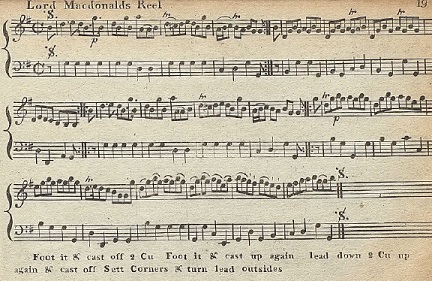 Figure 15. Lord Macdonalds Reel from William Campbell's c.1793 8th Book. Image © National Library of Scotland.
Figure 15. Lord Macdonalds Reel from William Campbell's c.1793 8th Book. Image © National Library of Scotland.
Our next tune is named Lord MacDonald's Reel. This tune is unusual for not being named in dedication to Lord MacDonald, rather it is understood to have been composed by Lord MacDonald (c.1745-1795) himself. Macdonald held titles in both the Scottish and Irish peerages and had a career in the military. He was the president of the influential Highland Society of London in 1791 which is the approximate date at which our tune was composed. He is known to have composed other dance tunes too, examples of his work were published in collections issued by Niel Gow amongst others; one other such tune was even named The London Highland Society. Our tune, which carries his name, was probably his most successful composition. Lord MacDonald's Reel first appeared in print around the year 1791, it would remain in print in both London and Edinburgh for much of the next twenty years. It was evidently a favourite tune. Two major variants of the tune are known, one was arranged in four strains of music and the other in only two. Both variants were widely published. The first appearance of the shorter version of the tune may have been in Edinburgh in John Anderson's c.1791 A Second Selection of the most Approved Highland Strathspeys, Country Dances, English & French Dances, the longer version appeared shortly thereafter in Niel Gow's 1792 A Third Collection of Strathspey Reels &c.. Other publications of the shorter version of the tune include Malcolm MacDonald's c.1792 A Third Collection of Strathspey Reels, the Preston collection of 24 Country Dances for 1793, Kauntze's c.1799 Collection of the most favorite Dances, Reels, Waltzes, &c., Walker's c.1805 5th Number and also his c.1806 11th Number, Napier's c.1806 Selection of Dances & Strathspeys, Thomas Wilson's 1816 Companion to the Ballroom and Nathaniel Gow's 1818 Part First of The Beauties of Niel Gow. The longer version of the tune can also be found in Campbell's c.1793 8th Book (see Figure 15), Aird's c.1794 4th volume of A Selection of Scotch, English, Irish and Foreign Airs, Longman & Broderip's c.1795 5th Book, Dale's c.1806 8th Number and in Goulding's c.1813 31st Number. A further variant of the tune can also be found in John Gow's c.1795 A Favorite Collection of Slow Airs, Strathspeys and Reels. The tune was also danced socially. Events known to have included the tune include The Duchess of Chandos's Ball in 1802 (Morning Post, 26th of April 1802), Mrs Hamilton's Masqued Ball in 1805 (Morning Post, 29th of June 1805), The Duchess of Gordon's Ball in 1806 (Morning Post, 8th of March 1806), a Ball at Brighton Castle in 1806 (The Sun, 14th of August 1806), The Master of the Ceremonies Ball in Ramsgate in 1807 (Morning Post, 26th of September 1807) and at Lord Macdonald's Dinner and Ball in 1808 (Morning Post, 23rd of April 1808). It was also etched on to the drum of a Barrel Organ that was advertised for sale in 1798 (Caledonian Mercury, 24th of March 1798). We've animated a suggested arrangement of the Campbell version of c.1793 (see Figure 15). Note: we've studied this tune a second time in another paper, you can read more here. For futher references to the tune, see also: Lord MacDonald (4) at The Traditional Tune Archive.
Paddy O'CarrolThe Ball was opened at half-past nine, by his Royal Highness, with Mrs McMahon, to the tune of Paddy O'Carrol.(Margate Ball) 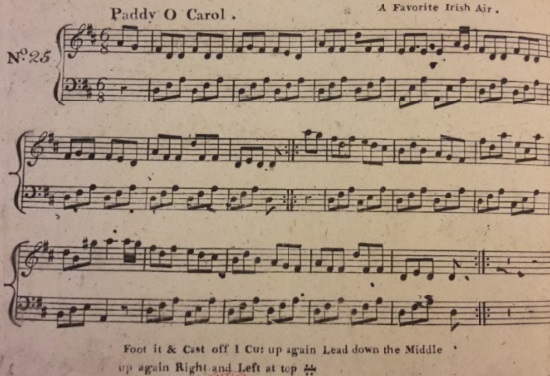 Figure 16. Paddy O Carol from William Campbell's c.1807 22nd Book. Image © THE BRITISH LIBRARY BOARD, b.96. ALL RIGHTS RESERVED.
Figure 16. Paddy O Carol from William Campbell's c.1807 22nd Book. Image © THE BRITISH LIBRARY BOARD, b.96. ALL RIGHTS RESERVED.
The next tune we'll investigate is named
The name
The precise chronology of publication of the tune is unknowable. One of the earlier music sellers to issue the tune in London was Goulding & Co. who published it as The tune was also danced socially. In addition to our 1811 Ball it is also known to have been danced at another Ball held in Margate in 1812 (The Star, 9th of January 1812). Perhaps it was a favourite tune amongst the dancers at Margate. We've animated a suggested arrangement of Campbell's c.1807 version (see Figure 16). For futher references to the tune, see also: Paddy O'Carrol (1) at The Traditional Tune Archive.
Blaise et BabetThe second and third dance was led off by his Royal Highness, with the beautiful and accomplished Miss Thompson, to the tunes of La Blaize Berbet and ...(Margate Ball) The final tune we'll investigate in this paper was named as La Blaize Berbet. No tune of this precise name is known to have existed (at least by me), I imagine instead that a popular tune named Blaise et Babet was danced at our ball, the title having been confused in transmission. 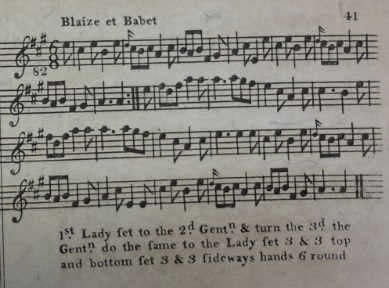 Figure 17. Blaize et Babet from what I've guessed to be Preston's 24 Country Dances for the Year 1789.
Figure 17. Blaize et Babet from what I've guessed to be Preston's 24 Country Dances for the Year 1789.
Blaise et Babet was a comic operetta produced in Paris in 1783, the music was by Nicolas Dezède (1740-1798) and the libretto by Jacques Marie Boutet de Monvel (1745-1812). The
The first of our dances was actually a Cotillion dance, it appeared in Longman & Broderip's 1786 Book the VI, Twenty Four New Cotillions under the name It's surprising that a tune from the 1780s would be danced at Margate in 1811, seemingly in isolation. I have no evidence of the tune being danced elsewhere at a similar date, or even of it having been published in the early 19th century at all. Perhaps this particular tune was a favourite of Miss Thompson, the lady who danced down with the Duke of Clarence, perhaps her family owned a Barrel Organ which played the tune. A new ballet named Blaise et Babet; or, La Fete au Village was advertised in Dublin in 1815 (Dublin Evening Post, 4th of March 1815) with music by Bossi and the Finale by Jean Jacque Rousseau, this might hint that the earlier work had remained sufficiently popular to inspire a sequel. However it came to be, this particular tune from 1781 is probably what was danced in Margate in 1811. My archives are incomplete of course, it's always possible that a better candidate tune will emerge. We've animated a suggested arrangement of what I've identified to be the Preston version of 1789 (see Figure 17). For futher references to the tune, see also: Blaize et Babet at The Traditional Tune Archive.
ConclusionIn this paper we've investigated nine different country dancing tunes that were featured at seven different society balls of 1811. We've noticed two couples dancing together who would go on to marry (William Pole and Catherine Tylney Long at Lady Metcalfe's ball, and Frances Kensington and Edward Whitmore at Mr Kensington's Grand Ball). We've identified the leading man at a ball leading off with a married lady (the Marquis of Downshire and Lady Harriet Savage at the Hillsborough Ball). We've observed several medley tunes being danced (the Marquis of Queensberry's Medley, The Prince Regent's Medley, The Castillian Dance, a Waltz Medley and also Gow's Pic Nic medley dance). We've also encountered a good number of tunes that were all composed by the supremely popular Nathaniel Gow. We've found a tune dedicated to a child and a tune that was probably composed by a deceased friend of the host. We've encountered tunes of recent composition and tunes that had been in circulation for decades, tunes purported to be of Scottish origin, Irish and English origin. We've seen a good deal of variety amongst the tunes danced to in 1811. We will however leave the study here.If you enjoy recreating the balls of the past then the tunes and dances encountered in this paper would be very suitable for any event themed around the year 1811. And as always, if you have anything further to share then do please Contact Us as we'd love to know more.
|
Copyright © RegencyDances.org 2010-2025
All Rights Reserved